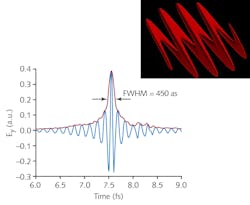Attosecond OAM pulses created simply by a self-denting target
Electromagnetic waves can carry angular momentum, which can be transferred in two ways. First, an object irradiated by an elliptically or circularly polarized electromagnetic is affected by the wave’s rotational moment, resulting in the so-called Sadovsky effect. Second, an object can be twisted by electromagnetic waves with a “vortex” wave structure, otherwise termed orbital angular momentum (OAM). Visible or infrared-range electromagnetic pulses with such capability are already used in telecommunications to increase the data-transfer capacity of fiber-optic networks. Generating intense OAM pulses in the UV range is a rather challenging task which, if solved, will open up new possibilities for exploring and developing new materials at characteristic spatial (tens of nanometers) and temporal (hundreds of attoseconds) scales. Such high-resolution visualizations are used to study and predict materials’ properties.
Scientists at the Chinese Academy of Sciences (Shanghai, China), Helmholtz Institute Jena (Jena, Germany), and the Skolkovo Institute of Science and Technology (Moscow, Russia) have come up with a straightforward way to generate intense short UV OAM pulses, which they demonstrated theoretically and in computer modeling. In the simulation, an ultrafast circularly polarized Gaussian laser pulse with a peak intensity of 1.7 × 1019 W/cm2 and a pulse duration of 2.67 fs strikes an initially plane target that self-dents because of the radiation pressure of the pulse; due to the resulting off-axis laser field, the dent allows the target to produce harmonic generation. The spin angular momentum of the incident pulse is transferred to the reflected harmonics, which are in the form of a train of 450-attosecond pulses. The team is now preparing an experimental verification of the proposed effect, and believes the technique can aid in the study of electron motion dynamics in various materials and condensed matter. Reference: J. W. Wang, M. Zepf, and S. G. Rykovanov, Nat. Commun. (2019); https://doi.org/10.1038/s41467-019-13357-1.
About the Author
John Wallace
Senior Technical Editor (1998-2022)
John Wallace was with Laser Focus World for nearly 25 years, retiring in late June 2022. He obtained a bachelor's degree in mechanical engineering and physics at Rutgers University and a master's in optical engineering at the University of Rochester. Before becoming an editor, John worked as an engineer at RCA, Exxon, Eastman Kodak, and GCA Corporation.

